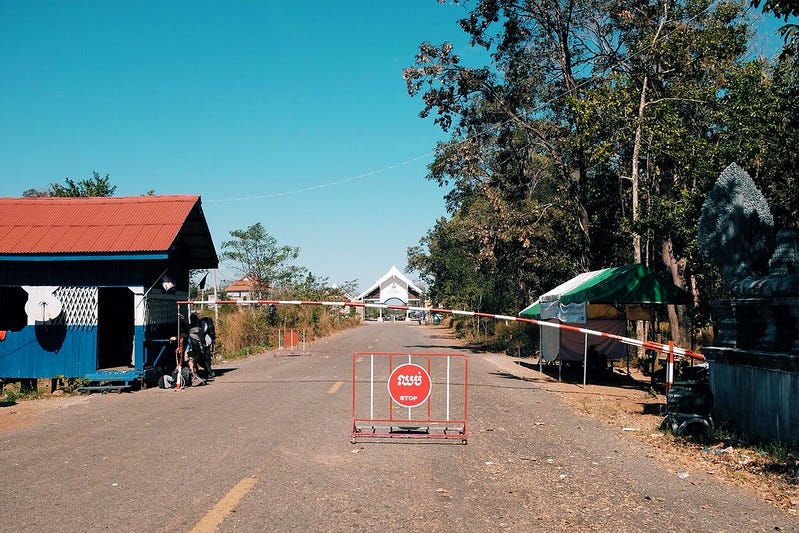Hello friends!
It is Laos Friday again and this one is spectacular. Our writer takes a look at what borders really mean for a region whose people have traded, lived and worked between forever. There’s a way to work around invisible lines drawn by colonial and regional powers — and a way to work around COVID-19.
I’m thrilled to be running some original content from the region’s best writers, but I want more! I’m super open to anything and everything just has to be from the region and pandemic related. All the students who have hit me up for the Under-30 freebie, I’m looking at you. Hit reply and we can chat ideas. And it’s paid!
To keep supporting this project please consider signing up for a premium membership, which includes the Monday region-wide wrap up.
This Monday I took a look at the Rohingya conversation in Malaysia, but have dug a little deeper for the Diplomat.
Stay safe out there and see you next week,
Erin Cook

A border crossing between Cambodia and Laos in 2015 (via phalkun p)
When Laos’ borders closed for the coronavirus lockdown, I figured that was the last time I’d see sliced bread for a while.
As I knew, Laos is a country that doesn’t eat much bread; imports a lot of its food; and had now closed its borders to all but essential traffic.
Then, last week, a shock: a surprise shipment of bread. Word got around fast, via Facebook. There was a squall of glee from the foreigners. Within hours the bread was gone.
A COVID miracle: Just how did this extremely non-essential good get here?
It testifies I suspect, to the craftiness of the Lao who — as they do — find ways.
A month into lockdown, I’m impressed at how well the food system, at least in my area, appears to be holding up. But from what I can see, stores remain stocked with most of the usual boxed goods, labelled in Thai, Vietnamese and Chinese. At the produce markets, there’s been no obvious disruption of the supply chains that bring holy basil, garlic, mushrooms or any other Lao staples, here. Prices have increased, which is to be expected, but it is not a disaster.
Laos is a primarily agrarian society; it has food security issues in the best of times. How is it pulling this off?
You can formulate a theory if you know a bit about Laos’ borders.
It was back on March 29 that the prime minister ordered a national lockdown. All border crossings were closed. Only freight, with the necessary papers, could enter Laos.
Interestingly, the order took pains to clarify that all border checkpoints, including “customary” and “local” ones, were included in the lockdown.
I’ve entered and exited Laos many times, but I’d never heard of these.
What’s a “local” checkpoint? I asked friends. I asked Google. None offered clear answers. The best I got was this: “They’re like these weird borders that only locals can use.”
What?
I set out to learn more about Laos and its borders. And in the process, I discovered something deeper — to my mind, truly beautiful — about the country in which I live.
Modern Laos has 5,000 kilometres of borders facing five countries: Vietnam, China, Myanmar, Thailand and Cambodia. These boundaries were drawn in the 20th century. But before that, Laos’ predecessor nations had centuries of interactions with the other nations of mainland Southeast Asia. Borders moved often; people stayed put.
You see vestiges of that in the complex cultural affinities that cross borders to this day. People have families and ethnic ties across borders. They cross to shop and also to hang out. There’s a reason Lao and Thai are spoken on both sides of the Mekong. Similar linguistic overlaps occur on other borders.
These communities are also vital points for commerce. Garlic travels through Laos en route to Thailand. Chinese-made construction materials arrive for Laos’ building boom. A Lao worker travels to Vietnam to her restaurant job, then returns at night.
“Local” border crossings (sometimes called “traditional”, “customary”, or “informal” crossings) exist to reflect this reality. They allow nationals to cross the border to do their business without the full shakedown of the immigration process. They’re closed to falang, who must instead show passports to the grim immigration officers at “international” checkpoints.
The exact number of “local” crossings is elusive, partly because they’re less formal, and also partly because anyplace is a crossing if you cross it. Laos’ borders are too long, and too remote, to monitor 100% of the time.
I’m a Westerner. For me, rules are clear. Nations are defined. Consequences are spelt out. My home country has become maniacal about border security.
Lao exist in a more fluid reality. They know goods, like sliced bread, can come in the formal way, via bridges and ports. But they also joke about the “midnight boats” that cross the Mekong to bring goods from Thailand — taking a pathway that’s been used for centuries and which will not be stopped by COVID-19.
It’s something to think about in this age of lockdowns and border closures and travel bans. No nation is a fortress. However many doors Laos might close, it is never truly closed to the world.

